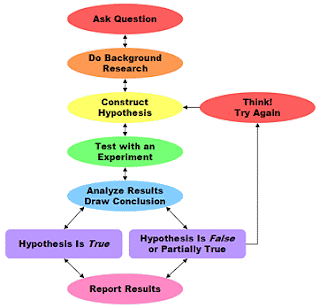Monday, September 21, 2009
Chemistry Test Review
Energy changes are NOT changes in matter.
After observing a series of experiments a chemist can develop a THEORY to explain these observations.
Matter has two general types of properties:
1. extensive- "how much" such as mass and volume
2. intensive- does not depend on how much such as density.
Physical properties include- melting point, hardness, color, evaporation .
Chemical properties depend on how the substance combines with other substances: rusting, combining with oxygen.
States of Matter
Solid- definite shape and volume
Liquid- definite volume, takes the shape of its container/ indefinite shape.
Gas- indefinite volume, fills its container, easy to compress, expands when heated.
Vapor- gas phase of a substance that typically a solid or gas at room temperature.
Mixture- a blend of substances which are "easily separated".
Homogeneous mixture- same throughout, not chemically combined, "stainless steel".
Heterogeneous mixture- not the same throughout, soil, Italian salad dressing.
Chemical compound- substances that are chemically combined, can only be separated by chemical means.
During a chemical reaction matter is NOT created or destroyed, only changed.
Wednesday, September 16, 2009
Physical Science Wed Stuff
Density = mass/volume, typically units are g/ml
Algebra
The old standby "Cross Multiply and Divide". This can be used when you have two ratios equal to each other.
a/b=c/d
Step 1- Cross multiply numerator on the left side x denominator on the right. In our example (ad)
Cross multiply denominator on the left side x numerator on the right. In our example (bc)
So we get ad=bc
Let's solve for the four variables.
Step 2 - Divide,
Solving for a ad/d= bc/d ------> a= bc/d
Solve for d ad/a= bc/a -------> d= bc/a
Solve for b ad/c = bc/c -------> ad/c = b
Solve for c ad/b = bc/b --------> ad/b = c
Tuesday, September 15, 2009
Sunday, September 13, 2009
Chem and Phy Sci- Graphing

2. Plan ahead! Note the largest value number to be plotted on each axis and make sure your scale is large enough so that you use up at least half of the paper in both directions.

3. Label the axis and give units to those labels in parenthesis: LABEL (UNITS) as in distance (cm).
4. All graphs should have a title. A good title that always works is "y" as a function of "x" as in (A). The independent variable is usually plotted on the horizontal (x) axis. "Distance as a Function of Time" is a good title for graph (B).

5. Most graphs should start at the origin (x = 0, y = 0). There are exceptions like graphing temp. If your lowest temp. is 51o C start at 50o C. This is because 0o C has no special meaning (0 cm means no distance, 0o C doesn't mean no temperature).
6. Pick a logical scale, counting by .1, 1, 2, 5, or 10 etc., not 3, 5, 7, 9, etc.
7. Put a small circle around each data point lightly in pencil. This is necessary due to the uncertainty in the data. Excel will do this for you.
8. Look at your points. Draw the best straight line or smooth curve that goes through as many points as possible. Point to point connections are usually not used in science but are quite valid for plotting irregular data which does NOT display any regularity - like gold prices. Try to miss as many points above the line as you draw as below. Excel will do this for you, as will many graphing programs.
9. If 2 or more lines are plotted on a graph a key is needed. It should be placed on the right side and toward the top if possible. A different color ink must be used for each line. Again Excel will do this for you.
10. If you have a straight line though the origin you have a direct proportion (A). When one variable goes gets larger so does the other. In graph (B) you have an inverse relationship. When one value becomes larger (say pressure) the other (volume) gets smaller.

Here is a quick check list:
TITLE, KEY (if needed), LABELS + UNITS, BIG ENOUGH, LIGHT CIRCLES AROUND POINTS, SMOOTH LINES/CURVES
